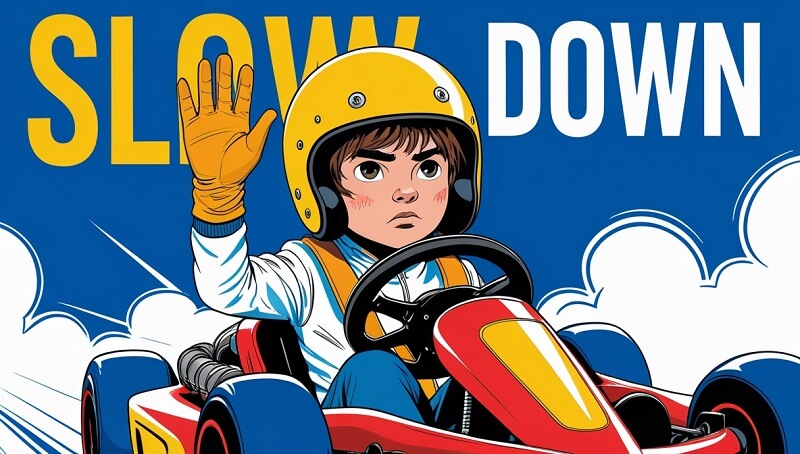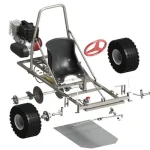Hey there, fellow racers! After spending over 15 years teaching go-karting and witnessing countless track situations, I can’t stress enough how crucial proper hand signals are. You know what’s shocking? More than 70% of track incidents could be avoided with better communication! Let me share some real-world wisdom about these essential signals that could literally save your race day.
| Key Takeaways |
|---|
| Always raise your hand high and clear when slowing down - this is the most important safety signal you'll use on the track and should become second nature. |
| Signal mechanical issues immediately by tapping your helmet - don't wait until a small problem becomes a major safety hazard for everyone on the track. |
| Give passing signals early and stick to them - point clearly to the side you want faster karts to pass on, and never change your decision mid-maneuver. |
| Practice signals before hitting full speed - spend time learning proper form in the pits first, ensuring your movements are bold and visible to other drivers. |
| Acknowledge other drivers' signals - a quick nod or hand gesture shows you've understood their intentions, creating a safer racing environment for everyone. |
Why Hand Signals Matter in Go-Karting
I’ll never forget my first racing incident back when I was starting out. I had no idea what the driver in front of me was trying to communicate, and let’s just say it led to some pretty exciting (but unnecessary) evasive maneuvers! That experience taught me a valuable lesson about the importance of track communication.
On the track, verbal communication is practically impossible. The roar of engines, wind noise, and helmets make speaking to other drivers a non-starter. That’s where hand signals become your best friend. Think of them as your universal language at speeds of 40+ mph!
What really drives this home is that every single professional racer I’ve worked with emphasizes the same thing: clear hand signals aren’t just about courtesy – they’re about survival on the track.
Basic Safety and Navigation Signals
The most important signal you’ll use is the “slowing down” indication – raise your hand straight up and hold it steady. I always tell my students to practice this signal until it becomes second nature. It should be as automatic as checking your mirrors!
One thing that surprised me when I first started teaching was how many people assume others can read their minds on the track. Trust me, they can’t! That’s why I’m particularly adamant about exit signals. A simple point to the side you’re exiting can prevent so many potential accidents.
Racing and Passing Signals
The most common mistake I see? Inconsistent signals during passing. You need to be crystal clear about your intentions. When you’re being lapped by a faster kart, point to the side you want them to pass on. Don’t waffle between sides – that’s how accidents happen!
I’ve developed a simple rule for my students: “Signal early, signal clearly, and stick to your decision.” This approach has prevented countless track incidents and made everyone’s racing experience more enjoyable.
Mechanical Problem Signals
The key mechanical signals are pretty straightforward, but timing is everything. If you feel any vibration or handling issues, immediately tap the top of your helmet and start moving to the outside of the track. I’ve learned through experience that it’s better to signal too early than too late. Remember that time I ignored a slight vibration? Yeah, that ended with a very expensive repair bill!
For brake issues specifically, I teach my students to pat the back of their helmet while gradually slowing down. This specific signal has saved more than a few bumpers in my years of teaching!
Teaching and Learning Hand Signals
Here’s something most guides won’t tell you: practicing hand signals in a stationary kart feels completely different from using them at speed.
One of my favorite exercises is what I call the “pit lane parade.” Before hitting the track, new drivers practice all their signals while slowly driving through the pit lane. It’s amazing how much more confident they become after just 15 minutes of this exercise.
The biggest mistake I see? Timid signals. Your hand movements need to be bold and clear – this isn’t the time for subtle gestures! I always tell my students, “If you’re going to signal, make it count!”
Advanced Racing Signals
After mastering the basics, there’s a whole world of advanced signals to explore. Team racing brings its own set of unique signals, and weather-related communication becomes crucial. I remember a championship race where proper weather signals between teammates made the difference between victory and defeat.
Competition-specific signals vary by track and event, but there’s one constant: they must be clear and consistent. I’ve seen teams develop their own sophisticated signal systems, but they always build on the fundamental signals we’ve discussed.
Conclusion
After years on the track, I can tell you with absolute certainty that mastering hand signals is a very important skills to develop as a go-kart racer. It’s not just about safety – though that’s paramount – it’s about becoming a more complete and respected driver.
Remember, every professional racer started where you are now, learning these same signals. Take the time to practice them, use them consistently, and teach them to others. The karting community becomes safer and more enjoyable when we all speak the same silent language on the track.
I’d love to hear about your experiences with hand signals on the track! Drop a comment below about any interesting situations where proper signaling made a difference in your racing. And don’t forget to share this guide with your fellow racers – we’re all in this together.

Goran, an experienced go-kart racer, fuels GoKartLife.com with his passion and expertise. He offers valuable insights and tips for fellow enthusiasts, fostering the growth of the go-kart community. Join Goran at GoKartLife.com and immerse yourself in this exhilarating sport.
Last modified: February 16, 2025



